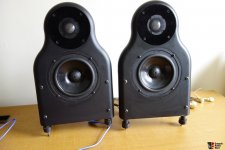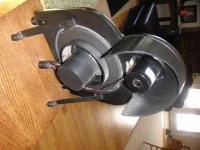I assume and hope that that award was for the equipment, not that particular installation.
I bet this particular installation got award from IKEA
Baffle design, Diffraction, Radiation pattern & sound perception
The discussion here has inspired me to talk in very simple terms about
"Baffle design, Diffraction, Radiation pattern & sound perception" at
Burning Amp 2017
Analog XO/EQ
Simpler than here:
Acoustics & Mechanics
SL
The discussion here has inspired me to talk in very simple terms about
"Baffle design, Diffraction, Radiation pattern & sound perception" at
Burning Amp 2017
Analog XO/EQ
Simpler than here:
Acoustics & Mechanics
SL
Sorry i am losing all interest for discussing each other beliefs...
I also lost interest,
 http://files.diyaudio.com/forums/images/smilies/wave.gif
http://files.diyaudio.com/forums/images/smilies/wave.gifwhat you are talking about
is just the usual heated soup.
play infinitely without finding the solution.
the science of sound reproduction is another thing.
A little more complicated ..
not for weak minds.
The discussion here has inspired me to talk in very simple terms about
"Baffle design, Diffraction, Radiation pattern & sound perception" at
Burning Amp 2017
Analog XO/EQ
Simpler than here:
Acoustics & Mechanics
SL
Reading about LXmini woofer reminded me of a design I had written to You about a couple of years ago (after that You posted a link on the Constant directivity loudspeaker designs page) ie. Yoshii9 of Time Domain Japan:
TIMEDOMAIN
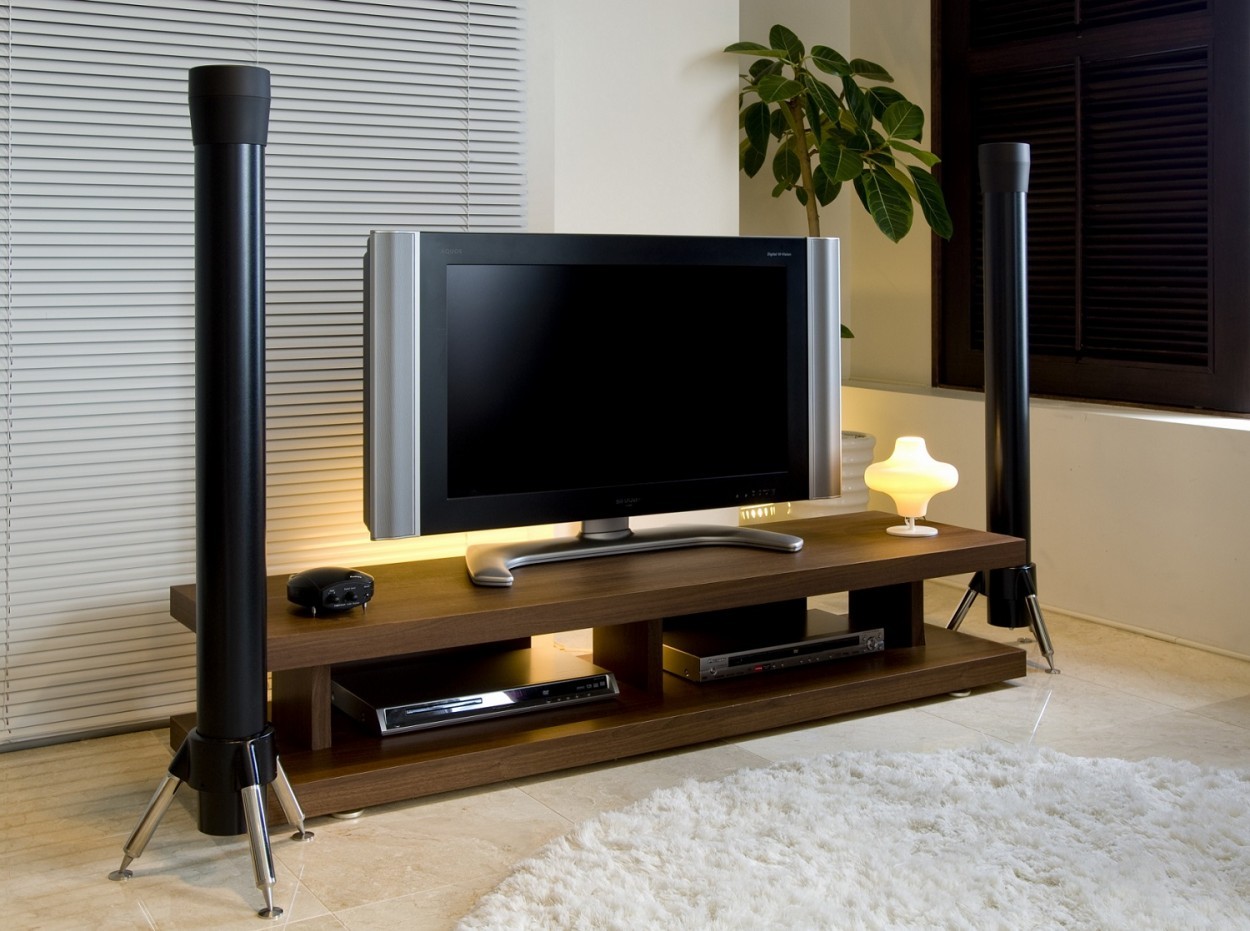
I am aware that You use the up-firing woofer only below 1 kHz while Mr Yoshii uses a small driver fullrange but what do You think of it?
What possible advantages/disadvantages?
Can the small fullrange be replaced by a bigger up-firing coaxial speaker for better results? How could this approach possibly compare to Pluto/LXmini approach?
The discussion here has inspired me to talk in very simple terms about
"Baffle design, Diffraction, Radiation pattern & sound perception" at
Burning Amp 2017
Analog XO/EQ
Simpler than here:
Acoustics & Mechanics
SL
Dear Siegfried,
Thank you for sharing such a wealth of knowledge!
Martijn
another similar design: Trevor Marshall - Ground Effect Omnidirectional HiFi Loudspeakers
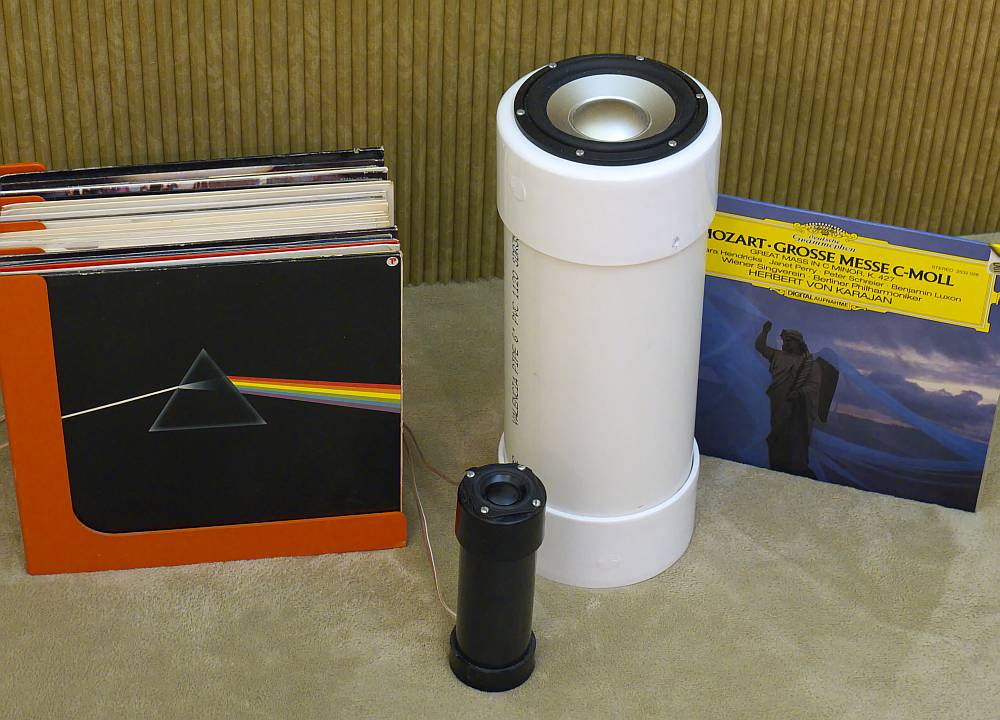
and yet another: Omuni Omnidirectional Loudspeakers Announced – witchdoctor.co.nz
Home - OMUNI AUDIO


and yet another: Omuni Omnidirectional Loudspeakers Announced – witchdoctor.co.nz
Home - OMUNI AUDIO

This kind of upwards radiating speakers don't give hardly any direct radiation above 2-3kHz. Tonal balance must be quite "smooth an mellow" if no equalization is used. That's why Linkwitz's Pluto an LXMini have vertically positioned tweeters that must be pointed towards the listener.
Old near-wall speakers like Sonab OA and Larsen had/have several tweeters to spread out high frequencies. They were originally designed for mono sound/single unit - they spray the music in a room quite well...
Larsen HiFi 8 loudspeaker | Stereophile.com
Speakers - CarlssonPlanet
I have a pair of these OA-14 at my summer cabin!
Old near-wall speakers like Sonab OA and Larsen had/have several tweeters to spread out high frequencies. They were originally designed for mono sound/single unit - they spray the music in a room quite well...
Larsen HiFi 8 loudspeaker | Stereophile.com
Speakers - CarlssonPlanet
I have a pair of these OA-14 at my summer cabin!
An externally hosted image should be here but it was not working when we last tested it.
Last edited:
This kind of upwards radiating speakers don't give hardly any direct radiation above 2-3kHz. Tonal balance must be quite "smooth an mellow" if no equalization is used. That's why Linkwitz's Pluto an LXMini have vertically positioned tweeters that must be pointed towards the listener.
[/IMG]
this is not necessarily a problem:
http://www.diyaudio.com/forums/multi-way/10962-stereolith-loudspeakers-question-67.html#post2732948
- there are measurements too
apparently there is sufficient direct radiation
The reality is that all the baffle work you can do can never eliminate baffle diffraction. Besides a sphere there is always some diffraction,it is a given.
Even a sphere has diffraction, but it can be shown to have the least diffraction for any given volume.
Diffraction depends on the rate of change of the surface, or the second derivative of the surface (the first derivative simply being the angle of the baffle, which can always be made zero by choice of coordinates.) So any edge will have high diffraction unless it is rounded. The more gradual the rounding the less diffraction. But "gradual" depends on wavelength so for a given radius the curve is gradual to HFs, but sharp to LFs.
The examples shown at the beginning are poor designs for diffraction as they still have sharp edges. These designs are easy to build, but less than ideal. Certainly better than most boxes however.
You can of course *effectively* eliminate the effects of baffle diffraction through absorption.
Also, as others have already suggested: making it maximally diffractive at a freq. sufficiently above it's passband (with an appropriately steep crossover) is also effective. (..basically the "no-baffle" approach eventually adopted by JohnK and SL.)
(..and a combination of the two methods should work well for those requiring a less "steep" crossover/wider-passband.)
As a study, it might be interesting to determine:
1. at what freq.s diffraction effects are deemed increasingly negative to a listener, and
2. at what amplitudes relative to the average are diffraction effects deemed increasingly negative to a listener, and
3. (in relation to pressure-loss), which is deemed more negative: either broad passband diffraction effects or narrow passband diffraction effects.
Also, as others have already suggested: making it maximally diffractive at a freq. sufficiently above it's passband (with an appropriately steep crossover) is also effective. (..basically the "no-baffle" approach eventually adopted by JohnK and SL.)
(..and a combination of the two methods should work well for those requiring a less "steep" crossover/wider-passband.)
As a study, it might be interesting to determine:
1. at what freq.s diffraction effects are deemed increasingly negative to a listener, and
2. at what amplitudes relative to the average are diffraction effects deemed increasingly negative to a listener, and
3. (in relation to pressure-loss), which is deemed more negative: either broad passband diffraction effects or narrow passband diffraction effects.
Last edited:
You can of course *effectively* eliminate the effects of baffle diffraction through absorption.
Also, as others have already suggested: making it maximally diffractive at a freq. sufficiently above it's passband (with an appropriately steep crossover) is also effective. (..basically the "no-baffle" approach eventually adopted by JohnK and SL.)
(..and a combination of the two methods should work well for those requiring a less "steep" crossover/wider-passband.)
As a study, it might be interesting to determine:
1. at what freq.s diffraction effects are deemed increasingly negative to a listener, and
2. at what amplitudes relative to the average are diffraction effects deemed increasingly negative to a listener, and
3. (in relation to pressure-loss), which is deemed more negative: either broad passband diffraction effects or narrow passband diffraction effects.
and perhaps diffraction effects have a detrimental effect also in the spatial domain, not only in tonality?
Edges and all other elements of the loudspeaker which reflect/diffract sound create secondary sound sources which leave the loudspeaker imprint on the reproduced sound unmasking it as an artificial sound source?
ps.
Philip Newell: "secondary diffraction sources that can smear the stereo imaging"
Recording Studio Design
rounding the edges or in-wall installation etc. may be not enough because diffraction is everywhere, just an example:
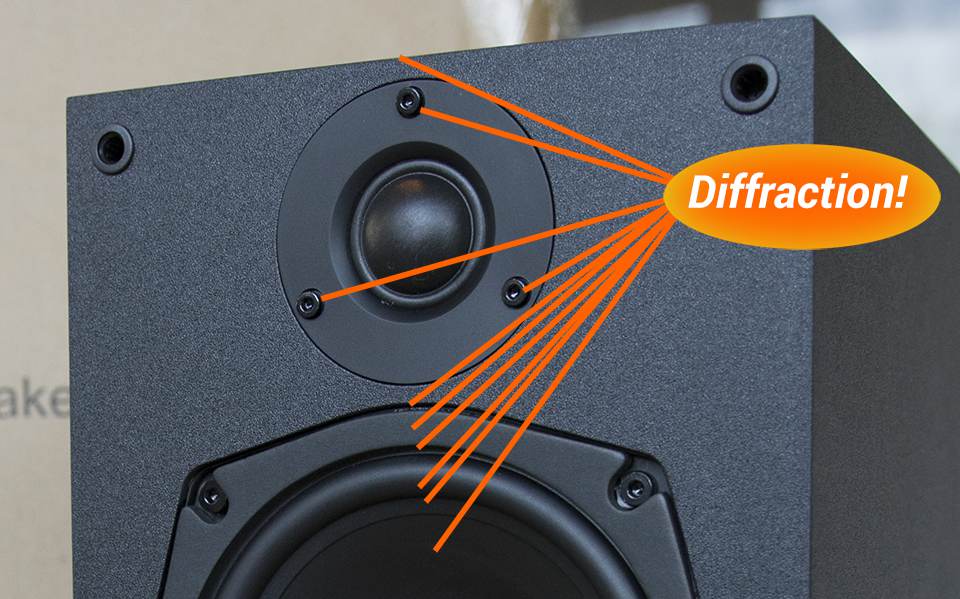
Philip Newell: "secondary diffraction sources that can smear the stereo imaging"
Recording Studio Design
rounding the edges or in-wall installation etc. may be not enough because diffraction is everywhere, just an example:

Add the word "can" and "may" all over the place, always a good idea
well, yes indeed, You may want to discuss with Mr Newell and all designers insisting on flush mounting etc.
With dome tweeters it's a good idea and then, of course, the woofer being so close is going to cause much bigger issues. I think there is a good case for a flat woofer diaphragm
and flat coaxials because diffraction is a major and inherent problem in coaxials
not neccesarily flat - here is a minimum diffraction coaxial proposed by Genelec:
An externally hosted image should be here but it was not working when we last tested it.
Baffle discontinuities may in fact have effects on diffraction
This is the test candidate, my W22 (LowMid) - W12 - (HighMid) - T29 (Tweeter) actual proto.
Now I made a measurement fo the T29 output with the array "as is" (red), and another measurement with the baffle cutout of the W12 obturated by cardboard (green).
There is clearly a difference to be seen. Whereas in the Pulse-Graph the difference seems not so impressive at the chosen, regular scale, the ETC graph shows a smoother decay of energy for the obturated (green) variation. So this W12 baffle cutout needs some reworking ...
Thanks for the ETC-hint, martijn (aka keyser)
This is the test candidate, my W22 (LowMid) - W12 - (HighMid) - T29 (Tweeter) actual proto.
An externally hosted image should be here but it was not working when we last tested it.
Now I made a measurement fo the T29 output with the array "as is" (red), and another measurement with the baffle cutout of the W12 obturated by cardboard (green).
An externally hosted image should be here but it was not working when we last tested it.
An externally hosted image should be here but it was not working when we last tested it.
An externally hosted image should be here but it was not working when we last tested it.
There is clearly a difference to be seen. Whereas in the Pulse-Graph the difference seems not so impressive at the chosen, regular scale, the ETC graph shows a smoother decay of energy for the obturated (green) variation. So this W12 baffle cutout needs some reworking ...
Thanks for the ETC-hint, martijn (aka keyser)
Last edited:
- Home
- Loudspeakers
- Multi-Way
- What are some good example of baffle design to improve diffraction

